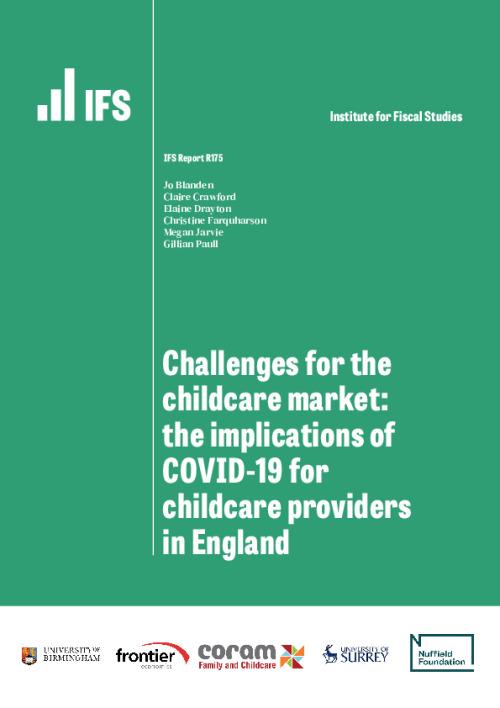The closures of childcare providers to most families during the COVID-19 crisis have underlined the importance of access to childcare, both to support paid work and to help shape young children’s environment. However, the crisis has had severe consequences for the finances of childcare providers, which were already weak in several parts of the sector going into the crisis. Despite a range of government support programmes, many providers lost income during lockdown. In the medium term, a longer-lasting fall in demand for childcare or an increase in costs related to social distancing could seriously hamper financial sustainability in the sector going forward.
In this report, we assess the consequences of the pandemic – and the resulting public health response – for the finances of early years childcare providers. The pandemic has hit demand for childcare hard: during the lockdown, when only vulnerable children and those with key worker parents were able to access childcare, fewer than 250,000 children aged 0 to 4 were attending childcare on a given day, compared to around 1.4 million before the pandemic. Since June, the sector has been allowed to serve all children in England, but even before the summer holidays, take-up peaked at 420,000 children.
We summarise the packages of support available to providers to help them cope with the loss of demand during the lockdown and over the next few months, and we model how these have interacted with the loss of income due to the crisis and with providers’ pre-existing finances. We also discuss how the changes to providers’ finances might affect capacity in the sector, and whether and how the government might intervene to support providers.
We find, unsurprisingly, that lockdown is likely to have damaged the financial health of many childcare providers, even after accounting for major government support programmes. Assuming that providers were not able to take in any income from parent fees, we estimate that a quarter of private-sector nurseries might have run a significant deficit during the lockdown (with at least £5 of costs for every £4 of income). Even if providers did manage to retain 15% of their normal fee income, either through retainers or by providing childcare to eligible families during lockdown, we still estimate that one in five are likely to have run a significant deficit during lockdown.
Of course, these figures reflect not just the pandemic, but also the pre-existing weakness in some providers’ finances. Even before the pandemic, 11% of private-sector providers were running a significant deficit; this could have been an unusual (and temporary) state of affairs, or a prelude to exiting the marketplace.
Childminders, who are mostly self-employed, have also been badly hit by the crisis. Even if all childminders received self-employment grants, the total loss of parent fees could see an additional almost 30% of childminders now earning less than £4 of income for every £5 of costs (counting what they usually pay themselves in the costs). In practice, many childminders will see their earnings take a hit, which could jeopardise their ability or desire to stay in the market.
Over the next six to 12 months, the key question for the sector will be how much demand for childcare recovers, and how quickly it returns, as government support is phased out. We have no special insight into this: it will depend on the paths that the economy and employment take, as well as the wider health concerns of parents. But, over a range of scenarios that we model, we estimate that, compared to the pre-crisis baseline, each 5 percentage point fall in income from parent fees and charges might see another 3% or 4% of providers tip into significant deficit if they do not make adjustments to their business, such as reducing the number of staff.
We also consider how providers might respond to these short- and medium-term financial risks. The financial pressures of the pandemic could lead more providers to raise fees, adjust their business models to reduce costs, or exit the market altogether.
Even before the pandemic, the childcare market experienced quite a bit of turnover each year as some providers left and new businesses opened up, meaning that the market was able to adjust to changes in parents’ preferences. But policymakers should keep a close eye on whether the pandemic has blunted some of these market forces, and whether the resulting landscape of provision is consistent with the government’s objectives for childcare to support working parents and reduce socio-economic inequalities.
If the government does wish to intervene to support the market, there are broadly two approaches it could take (which are not mutually exclusive). The first is to focus support on the otherwise viable businesses that slipped into significant deficit during the lockdown, helping them to adjust to the new post-crisis landscape. To do this, the government would need to focus support on providers who are mostly funded by parent fees, as they were less well protected during the lockdown, and may be the most susceptible to falls in demand over the medium term. Given the large numbers of providers that seemed to be experiencing significant deficits going into the crisis, the goal should not necessarily be to ensure that every provider keeps its doors open, but rather to offer temporary support to otherwise healthy businesses.
Another approach would be to prioritise support towards publicly funded childcare (through the free entitlement for children aged 2, 3 and 4). While public funding for childcare was protected through the crisis, most providers combine public and private income and so were often still vulnerable during the lockdown. Going forward, funding during the spring and summer terms in 2021 will be based on January 2021 pupil numbers, risking a loss of capacity if take-up is low at the start of the year but recovers quickly in the spring and summer. An increase in the funding rates paid for free entitlement hours would reduce the trade-off some providers face between offering lower-paid publicly funded hours and higher-paid privately funded hours and might therefore help to ensure that all eligible children continue to be able to access their entitlement to free early education.
Key findings
- During the lockdown, childcare providers have had access to continued funding for the directly publicly funded hours they deliver, as well as programmes such as business rates holidays, the furlough scheme (for employees) and the self-employment grants (for the self-employed). The decision to restrict providers to make furlough claims only for privately funded childcare was sensible as their public funding continued at normal levels through the 2020 summer term. However, the way that this was implemented could have left some providers unable to access the furlough programme fully.
- On average, and despite the furlough scheme and self-employment grants, the lockdown period is likely to have significantly damaged the finances of many childcare providers with income from parent fees. Under the pessimistic assumption that all fee income from parents dried up, we estimate that a quarter of private nurseriesmight have been operating at a significant deficit (with more than £5 of costs for every £4 of income). This compares to 11% of providers pre-crisis. Even if providers were able to retain 15% of their pre-crisis fee income, one in five are still likely to have run a significant deficit during lockdown.
- Providers that rely mostly on public funding have seen their income largely protected. For providers with income from parent fees, support through the furlough scheme and self-employment grants was a significant help but provided far from full protection: we estimate that the median furlough payment was worth 55p for every £1 of lost fee income, and self-employment grants covered 64% of baseline fee income at the median.
- Childminders, who are mostly self-employed, have also been badly hit by the crisis. Even if all childminders received self-employment grants, the total loss of parent fees could see an additional almost 30% of childminders now earning less than £4 of income for every £5 of costs (counting what they usually pay themselves in the costs). In practice, many childminders will see their earnings take a hit, which could jeopardise their ability or desire to stay in the market.
- In our data, we find that smaller providers, those with more highly qualified staff or those from more deprived areas are no more likely to have run at a significant deficit during lockdown. This contrasts – but is not necessarily at odds – with surveys of providers which find that those in disadvantaged areas are more worried about their financial future.
- The key question in the medium term is how much demand for childcare recovers, and how quickly it returns. We estimate that, for every 5 percentage point drop in fee income between 5% and 25% compared with pre-crisis levels, an additional 3–4 percentage points of providers are likely to face a significant deficit. These results are driven by childminders. If, in addition to low fee income, take-up of funded places is still below pre-crisis levels in January 2021, voluntary providers and nursery classes will be hardest hit.
- The extent to which government support for the sector will be needed going forward depends on how the market adjusts to changing levels of demand. Before the pandemic, the childcare market featured significant turnover and there was some spare capacity at around 70% of providers, suggesting that the market is mature and could potentially adjust to rises and falls in demand (at least at the national level). But the current fall in demand is unprecedented and the blow to providers’ finances could force some to close or shed places. So policymakers will need to monitor whether (and where) capacity comes back when demand starts to return. There are also risks around losing capacity for particular age groups or at particular provider types.
- If the government does wish to provide more support to the childcare market, the fact that many providers were running significant deficits going into the crisis means that the goal should not necessarily be to keep every provider’s doors open regardless of demand. If the government wants to focus on preventing the closure of otherwise viable businesses that tipped into a temporary deficit as a result of the pandemic, it should focus on providers that are largely funded by parent fees (including many childminders and private providers).
- Although most of the providers who largely rely on free entitlement funding were financially cushioned from the impact of the lockdown, they could see their incomes hit in 2021 if demand remains low in January – when take-up of funded childcare is measured to determine future funding levels. Of course, there could also be other reasons for the government to prioritise this part of the market, such as to support local authorities to fulfil their duty to ensure there are enough childcare places for every eligible child to be able to access their free early education entitlement.












